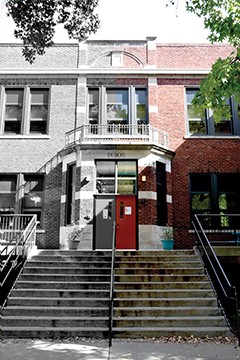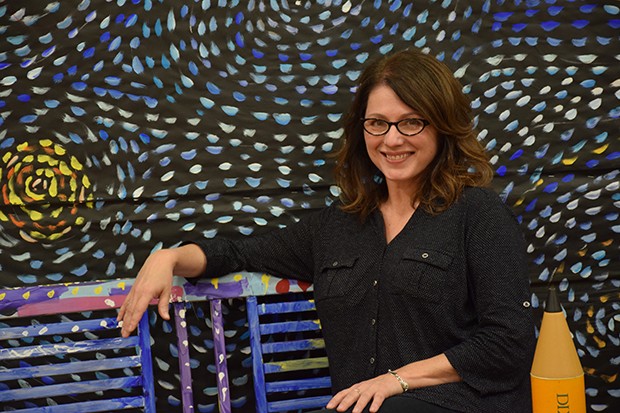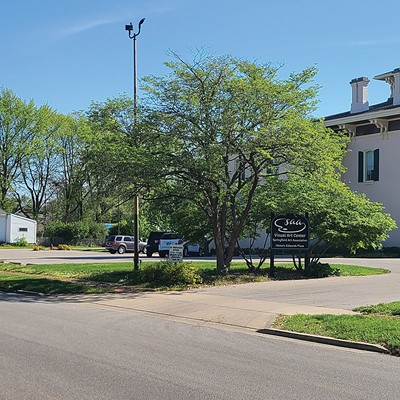
New Berlin, a village with 1,500 people separated from the outskirts of Springfield by 12 miles of pale blue skies and sunlit cornstalks, still has many hallmarks of a small town. It hosts the county fair, with chili cookoffs, livestock exhibitions and country music stars drawing crowds during the long days of June. Tractors occasionally join traffic on the main thoroughfare, and freight trains rumble and screech along tracks that travel the length of town. And, of course, the people in New Berlin, like much of rural Illinois, are almost entirely white.
Unlike a lot of rural towns, though, New Berlin is growing, and its schools in particular, with nearly 5 percent annual growth, are booming. Its elementary school attendance has more than doubled since 2003. The growth in the higher grades has been slower, but still some of the highest in the metro area.
The schools shape the town’s identity. German immigrants founded New Berlin in 1865, so, appropriately, the schools’ mascot is the pretzel. And Pretzel Pride is everywhere, from the stands at the baseball diamond, where the high school squad played en route to its first regional championship this year, to the top of the village water tower, which proudly proclaims the town to be “Home of the Pretzels.”
Students are surging into New Berlin schools, though, not because of the town’s rural charm, but because of its proximity to the suburban sprawl of southwest Springfield. As developers turn farmland into new homes, they are increasingly leaving the boundaries of Springfield’s core school district – District 186 – to do so. Even homes that are within the city limits of Springfield often don’t fall within the school district, because those boundaries aren’t the same. The decade-old, half-million-dollar houses in Springfield’s Centennial Park Place neighborhood, for example, barely fall inside the New Berlin school district.
The same thing is happening on nearly every side of Springfield; city residents, in fact, now go to seven school districts other than District 186. In the Chatham school district, more than a third of students have Springfield addresses.
The white flight undermines the goals that the desegregation order was meant to address, by re-creating separate but unequal education systems for black students and white students. Because schools are so closely tied to the neighborhoods where they are located, the rush of white families to suburban schools also leads to widening differences for the health, economic opportunities and quality of life between black and white residents in the Springfield region, as well.
The change is happening quickly. The number of white students in District 186 declined by a third in the 15 years between 2003 and 2018, but the number of black students in the district grew by 3 percent. Meanwhile, in the rest of the Springfield metro area, the number of white students only decreased by 4 percent. The number of black students in those outlying districts more than doubled, mainly because there were so few in those districts to begin with.
The consent decree: Correcting one problem, ignoring the big picture
Springfield’s District 186 is one of a few school districts still working under a federal desegregation consent decree. A group of both black and white parents sued the district in 1974 for concentrating black students in a handful of schools. They pointed out, for example, that 78 percent of all black students in the district at the time attended Southeast High School.
The school district and the plaintiffs agreed to a consent decree within months. The court found that the district violated the Fourteenth Amendment by “contributing to the creation, intensification and perpetuation of racial segregation in and among the public schools of Springfield School District 186.” The district, the federal judge added, had an “affirmative obligation to eliminate and prevent racial segregation in the public schools of District No. 186.”
The agreement prevents District 186 from using many of the tactics that led to the segregation in the first place. That includes drawing attendance zone boundaries that result in racially segregated schools, creating school-to-school transfer policies that resulted in racially segregated schools, assigning faculty or staff based on their race or ethnicity, sending less-qualified staff to predominantly minority schools, unequally distributing supplies and equipment among schools, applying tracking systems that discriminate between pupils based on their race, setting up systems that disproportionately subject minority students to discipline or offering extracurricular activities in a way that discriminates against students on the basis of race.
As far-reaching as the consent decree was, its biggest weakness is the fact that it only applies to a single district. During the months while the Springfield desegregation case was pending, the U.S. Supreme Court handed down a landmark decision in July in a Detroit-based desegregation case called Milliken v. Bradley. It was a 5-4 decision, and four of the five judges in the majority had been recently named by then-President Richard Nixon. The majority ruled that, in all but the most egregious circumstances, courts could not impose school desegregation plans that involved transferring students from one district to another. In other words, Detroit’s predominantly white suburban school districts would not be forced to integrate with Detroit’s increasingly black schools. And, of course, neither would Springfield’s.
The Detroit case marked a turning point in how the Supreme Court handled school desegregation cases. Twenty years after Brown v. Board of Education, the justices began limiting the circumstances and scopes under which minority residents could force racial integration of segregated schools. That culminated in a 2007 case in which the court ruled that schools could not consider the race of students when assigning them to schools. “The way to stop discrimination on the basis of race,” Chief Justice John Roberts wrote, “is to stop discriminating on the basis of race.”
Still, District 186 has never challenged its consent decree. A federal judge continues to monitor the process, and the district generates 1,000-page reports every year for local civil rights leaders to review.

That means racial segregation in the Springfield metro area is no longer a problem only within the city, but also across the entire metropolitan region. The schools reflect that shift. Calculations from Governing magazine earlier this year showed that, for schools in District 186 to all reflect the same black-white distribution of the district as a whole, about 18 percent of students would have to go to different schools. But across the whole metro area – city and suburbs alike – 63 percent of students would have to be reassigned to match the region’s racial makeup.
These days, black students (40 percent) in District 186 make up almost as big of a share as white students (44 percent). Nearly 11 percent of the district’s students identify as more than one race, 3 percent as Hispanic and 2 percent as Asian.
DuBois deals with demography
DuBois Elementary School, a century-old brick building in Springfield’s historic west side, has seen the same dramatic demographic shifts as the district as a whole. In 2003, white students made up 62 percent of DuBois’s 494 students. Now, they make up 32 percent of the students, even though the school is smaller. Black students, which make up 51 percent of the student body, are now the biggest demographic group. Kids who identify as two or more races make up another 13 percent.
Teachers and administrators there go out of their way to cater to the different learning styles and needs of the diverse student body. The school emphasizes hands-on learning for its STEAM-based curriculum that helps students explore science, technology, engineering, art and math simultaneously. Earlier this year, a group of fourth- and fifth-graders explored real-life examples of art with a tour at the newly renovated executive mansion downtown, which ended with a meeting with Gov. JB Pritzker. One of DuBois’ teachers, Dan Hartman, is one of 10 finalists for Illinois’ teacher of the year this year.
“We believe that every child learns in a different way and every child needs a varied approach to learning,” says Donna Jefferson, the school’s energetic principal. “We emphasize hands-on, experiential, real-world learning.”
Jefferson also wants the DuBois community to help students and teachers grapple with problems outside of the classroom, too. Amber Alexander saw that firsthand. She enrolled her two kids in DuBois, in part so they could be closer to her ex-husband. But when her ex-husband died last May, teachers from DuBois attended the funeral. People from the school called her to make sure the children were doing all right. Her daughter’s teacher had the class make condolence cards. “It was a really supportive environment,” Alexander says. “I like the fact that they’re like a family.”
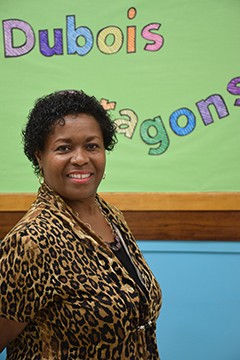
Outside perceptions of schools can shape nearby neighborhoods. Home buyers nationally say that getting into a good school district is their top priority in purchasing a house, and three-quarters of those who responded to a survey last year said they had to give up amenities like garages, updated kitchens or big backyards to get the school they wanted, according to the National Realtors Association. Nearly 60 percent of respondents said good test scores were a hallmark of good schools.
“School districts are an area where many buyers aren’t willing to compromise,” wrote Danielle Hale, the group’s chief economist, last year. “For many buyers – and not just buyers with children – ‘location, location, location,’ means ‘schools, schools, schools.’”
District 186 does use some tactics that other urban districts have tried in order to keep white families from leaving: it opened selective schools for gifted students after a charter school opened in 1998. The district’s two schools for gifted students draw a disproportionately large number of white students. At Iles Elementary, for example, more than half of the pupils are white, 18 percent are Asian and 14 percent are black. Half of the students at both Benjamin Franklin Middle and Lincoln Magnet School are white. The district’s single charter school, Ball Charter School, has a racial makeup that more closely resembles that of the district as a whole.
Aaron Graves, the president of the Springfield Education Association, the local teachers’ union, worries about the effect that the selective programs have on other district schools and their efforts to improve their academic performance. “These schools are doing fantastic things with their kids, but if you take 80 gifted kids from Washington and 80 gifted kids from Jefferson [both middle schools with more than 70 percent low-income students], how are those schools ever going to right the ship?” he asks.
Superintendent Jennifer Gill notes, though, that those programs have all been in place for decades. Almost all school districts serve gifted students with distinct programming, she adds. They were created, she says, as “a place to serve gifted students. They were not put in place to prevent white flight.”
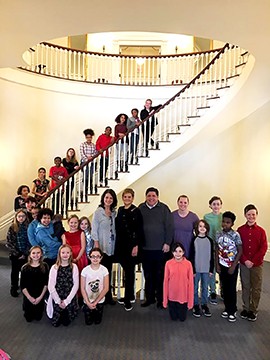
For years, the Ball-Chatham School District has offered Springfield-area residents a suburban alternative to District 186. But Ball-Chatham Superintendent Douglas Wood says that doesn’t put the two districts in conflict. “I wouldn’t necessarily say it’s a competition. I think many of the school districts around us do a wonderful job,” he says.
But the different districts cater to different family priorities, Wood says. Some families from smaller communities might be looking for smaller school districts. When Chatham administrators do look around at other school districts for comparison, they look to suburban schools in the Champaign, Peoria and Chicago areas, not just the Springfield area, Wood says.
The Williamsville-Sherman school district north of Springfield has seen some of the fastest growth of its schools in the metro area over the last 15 years, particularly in its elementary and junior high schools. Again, the vast majority of the growth has come from an increase in white students.
Superintendent Tip Reedy says new residents come there because of the schools, not racial homogeneity. The schools, he says, rank high in state ratings and are small enough that kids don’t get lost in the system. “That’s all I ever hear from the community: Great schools equal great communities,” he says.
New Berlin school board president Bill Alexander suggested that the move of predominantly white families to the district was “more economic flight [than] white flight,” because minority student enrollments had increased in many suburban districts, even though the overall numbers remained small. A quarter of students in the New Berlin school district are from low-income families.
While economic factors certainly play a role in white flight, there is also a growing body of research that suggests that race – not economics – is the root cause of the phenomenon.
The Pew Research Center found this year that 62 percent of white Americans said it was better for students to go to school in their own communities, even if the schools weren’t racially or ethnically mixed. By comparison, 35 percent of white Americans favored diverse schools over local ones. Black Americans responded almost exactly the opposite way: 68 percent favored the diverse schools, while only 28 percent chose local schools.

And if economic conditions did explain white flight, whites would migrate to the same places that middle class black, Asian or Hispanic residents moved to, says Indiana University sociologist Samuel Kye. “Almost all of our metro areas have diversified, but those trends have not trickled down to neighborhoods,” he says. In fact, Kye’s research found that whites in middle class suburbs are more likely to move when minorities arrive than whites in poorer areas.
The demographic shifts in District 186 have not made it easier to address longstanding race-related concerns.
Take the school board. Only two of its seven members are black, and that’s only been true since September, when Tiffany Mathis was appointed to fill a vacancy. There have occasionally been two black members of the board before (although never more than two), but for most of the last 19 years, Judith Ann Johnson has been the board’s only black member.
Johnson says she gets more constituent calls than most board members, because black families call her for help, even if they don’t live in her subdistrict. She knows she has a reputation for being outspoken and for asking tough questions. “People don’t like me, because I’m vocal,” she says. “When it comes to educating kids, I feel my kids should get the same thing as everybody else’s kids.”
Another major concern is the recruitment and retention of black teachers. In 1975, only 5.9 percent of Springfield’s teachers were African-American. By 2016, it was only 9.7 percent. The numbers have remained stubbornly low, even though the district has a full-time recruiter dedicated to finding minority candidates.
Gill, the superintendent, says a statewide teacher shortage is to blame. Fewer college students overall are going into education to begin with, and, during Illinois’ recent budget crisis, many of them went to out-of-state colleges. Until recently, though, Illinois required teachers to take additional coursework if they were transferring in from other states.
Other issues may be at play, too. Some black teachers who have worked in District 186 say they also have felt unwelcome among their colleagues in certain schools. The district doesn’t offer moving expenses or any other incentives to move to Springfield. Union rules that required the last-hired teachers to be the first to be laid off made it harder to keep new black teachers in the aftermath of the Great Recession. Plus, somewhat ironically, the district has focused on promoting qualified black teachers into administrative roles, but it has had a hard time replacing them in the classroom.
And even after nearly half a century of living under the desegregation order, there is still a widespread perception that the racial makeup of many schools is skewed, especially when it comes to the district’s three main high schools. White students make up the majority at Springfield High School, where they outnumber black students 2 to 1. At Lanphier High School in the north, whites make up 48 percent of students, compared with 39 percent for black students. And Southeast has a bigger share of black students (50 percent) than white students (40 percent).
But Gill, the Springfield superintendent, says the desegregation order still plays an important role in how the district operates. District officials have never considered challenging it, says Gill, who attended DuBois as a child and taught in the district before eventually leading it.
“I’ve never been a student, an educator or a superintendent who was not under the desegregation order and the consent decree,” she says. “So why would I live any differently than by the full letter of the law? It’s how I was raised, and how I was brought through the system.”
While Springfield schools wrestle with the consent decree’s requirements, though, the growth of the suburban schools all around them continues. In New Berlin, in fact, local leaders are exploring options for replacing the century-old building that hosts the junior and senior high schools to handle the burgeoning demand. The district already opened a new elementary school in 2009.
Daniel C. Vock is a national public policy reporter based in Washington, D.C., and a former staff writer for Governing magazine. He led a Governing team that reported the “Segregated in the Heartland” series earlier this year. Vock lived in Springfield from 1999 to 2005.

